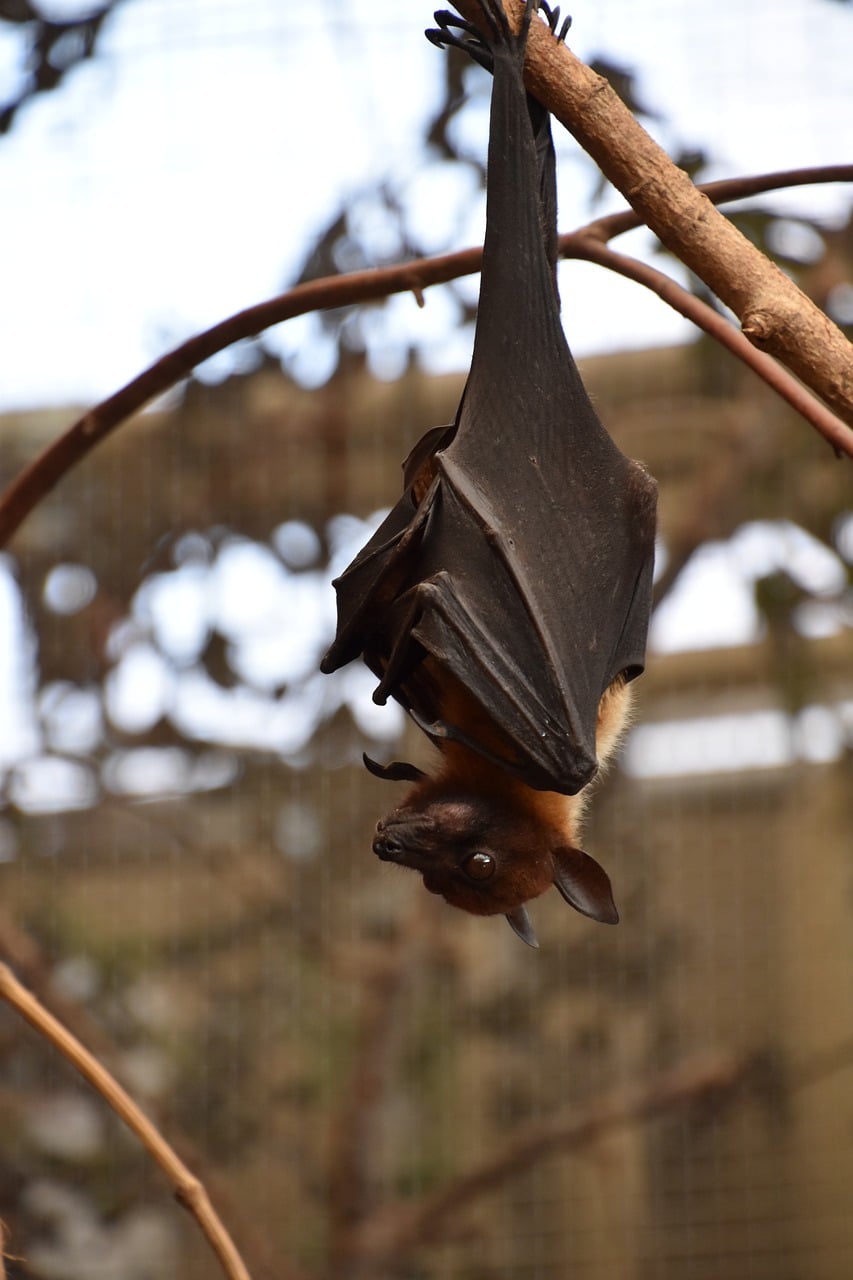
Suppose the bats’ only qualities were what we see portrayed in the TV and Movie industry. Then the answer would be no, they are not good to have around. They are shown as scary, blood-sucking vampires that strike fear in humans. But that is simply not all there is to being a bat. They are really fascinating creatures with many exceptional qualities. So can bats be good to have around? Absolutely.
In fact, their German name, die Fledermaus, means “flying mouse.’ That’s cute, right? Are you not buying it? Keep reading to learn more.
Getting to Know Bats
Bats are mammals with large, pointed ears, brown fur, and long arms and hands with long fingers. The muscular wings that are attached to their hands and legs are especially suited for their flight. Oh, and they happen to be the only mammal that can fly. In fact, they are more maneuverable in flight than birds. Pretty remarkable, right?
Bats are nocturnal, flying around at night and hanging in dark and secluded places during the day. You see, at night, they have fewer predators to contend with as they search for food. It only makes sense.
Most eat insects, fruit, pollen, birds, and smaller bats. (not human blood). Although, species to species, their diets may vary a little.
One of the most exciting bat facts remains how they use ultrasonic signals, called echolocation, to locate objects in the dark. Echolocation is how they navigate the world at night and look for food.

Bats in Alabama
If you live in Alabama, you are sure to have seen one or two flying around at night. Their flight patterns can be beautiful to watch as they dart to and fro. The most common bats in Alabama are listed here.
- Little Brown Bat: This typical bat has ears that are wide apart on its head, looking like mouse ears and a long tail. It uses echolocation to feed on insects and navigate in the dark.
- Big Brown Bat: A much larger bat, this one has light brown fur, and its wings are black and hairless. For some reason, it does not like moths, like other bats. However, they love beetles.
- Eastern Red Bat: As the name says, this bat has reddish fur with white patches on the shoulders, and it is considered a microbat. Its most unique feature is that it has a very low body temperature when it hibernates.
- Eastern Pipistrelle: With yellowish-brown fur, this bat is tri-colored. They are found near water and caves or abandoned buildings.
- Evening Bat: Found in the forest, this variety is dark brown with black ears. Interestingly, this microbat does not live in caves.
The Bat’s Best Qualities
To get to know the bat is to learn to love the bat. Believe it or not, their good qualities do exist. Bats are beneficial to our environment in the following ways.
- Bats are natural pest eliminators.
- They fertilize and pollinate crops and gardens.
- The rainforest depends on Bats.
- They may aid in human health.
Let us elaborate in the following notes about bats.
They Are Natural Pest Eliminators
There is no doubt, bats eat bugs, and we mean tons of bugs. In fact, farmers are grateful to the bats in their areas because bats save them millions of dollars in pesticides per year. The most common crops they protect are sugarcane, nuts like almonds and pecans, tomatoes, cucumbers, beans, corn, rice, and even cotton. Now that’s a good deal.
Pollination and Fertilization
Similar to bees, bats that eat nectar pollinate over 700 different plants. Although their method is a bit different. Additionally, some crops are dependent on bats. These crops include many of our favorite fruits like bananas, dates, figs, mangoes, peaches, and avocados.
As far as fertilization, you can probably guess. The bat’s guano is good for our gardens. It contains nitrogen, potassium, and phosphate, which are all good for the soil. And when their droppings have seeds, new plants are spread throughout the area. But, more about that in the next paragraph.
In The Rainforest
Well, bats are famous for one thing, for sure. Have you ever heard of seed dispersal?. In the rainforest, bats eat fruits, including seeds. Then, when the seeds come out in the guano, they have dropped far away from the host plant. An incredible feat of nature, this method of seed scattering spreads trees and crops all over the rainforest.
Bats and Human Health
Perhaps you have never heard this one. But vampire bat saliva has been found to contain an anticoagulant that helps treat stroke victims. And, if that was not enough, they are resistant to DNA damage and malaria parasites. So, scientists have been working on the bat DNA to better understand human DNA and effectively control or eliminate malaria.

A Protected Species
As a protected species, bats are illegal to kill. Which is excellent news for the farmers and rainforests of the world. If you suspect you have bats in your attic or on your property, let Covenant Wildlife Removal assist you with bat removal. We are a top-rated local family-owned, full-service wildlife trapping, removal, and damage repair service company. Our service technicians can remove a bat infestation before it becomes a massive problem for you and your family. We provide humane and safe bat removal services in Jefferson and Shelby counties. Contact us to set up an inspection.
An Infestation
Bats typically are not alone, so if you see a solo bat in your home’s attic, there are most likely others hanging around. Here are a few signs that you are dealing with a bat infestation requiring professional assistance:
- Nightly noises such as clicking, popping, and scratching as bats move around.
- Large quantities of bat droppings (guano) in your attic or loft.
- A strong toxic smell that is like ammonia.
- Dark stains around small holes in your home.
- Bats flying from your home at dusk.
What to Do if There are Bats in the House?
Remember, bats can see fine in the day, but when they’re sleeping, nesting, roosting, and looking after their pups, they want somewhere dark and relaxing. So, making the area unattractive to bats is the goal. Bats are seldom caught or trapped. They are shooed out in the following manner.
1. Install a series of brilliant floodlights. Turn their dark roosting space into a blindingly intense location that they can’t stand. Then aim the lights up towards the roofing system. For good coverage, install multiple lights that overlap with each other.
2. Running extension cords and shining lights all night, your electrical expense will go up for a while. But ultimately, the bats will look in other places for someplace more appealing.
3. Another way to chase bats out of your house is to overheat them. Bats choose warm, damp environments; however, they can’t stand hot, dry ones. A dehumidifier and a portable heater may do the trick. However, safety precautions must be taken with space heaters. It will take a while for the heat to dry out the location and eliminate any moisture attracting them. When all the wetness is gone, the dry, 100-degree heat will quickly become excessive for them, and they’ll leave.
Furthermore, if you have no desire to tackle the bats in your attic or crawlspace on your own, contact a professional wildlife removal company in your area.

Covenant Recognizes Bats Can Be Good to Have Around
Bats are fun to watch and are natural Alabama pest control. As you now know, there are many different types of Alabama bats, each with its own unique qualities. If you are interested in watching bats or maybe in keeping your gardens safe, you can build a bat box for your property.
However, if a colony of bats decides their new cave is your attic, you will want to get them out as soon as you can. No one wants an attic full of bat guano, and they can carry parasites and disease. Due to the toxins contained in the droppings, prolonged exposure can be very damaging to you and your family’s health.
Should you find bats sleeping in your attic, don’t panic. Call Covenant Wildlife Removal to shoo them out. In case you are not located in Alabama, we suggest you contact your local wildlife removal company.



